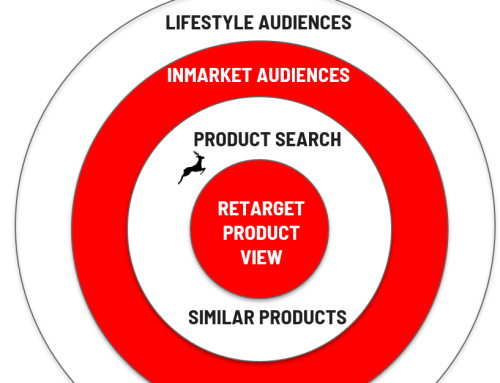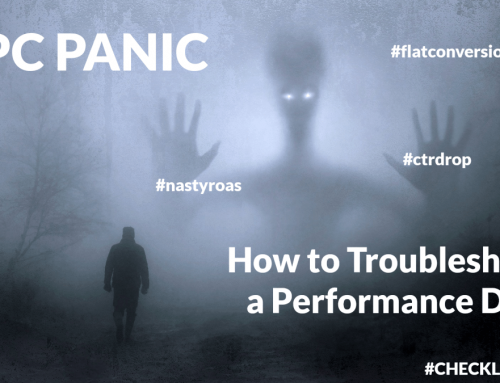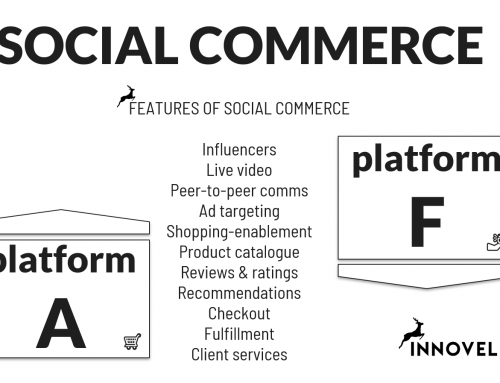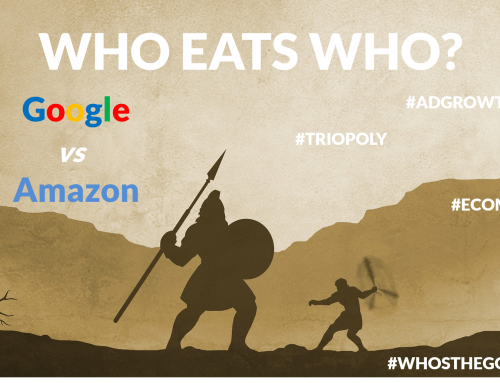I almost choked on my Café au Lait that day in a breakfast restaurant in Paris when the digital strategist said to me:

I was not involved in that project and suddenly felt very happy not to be. Maybe it was just a question of terminology, maybe something else was behind those words. You can’t remarket to something that hasn’t been marketed, can you?
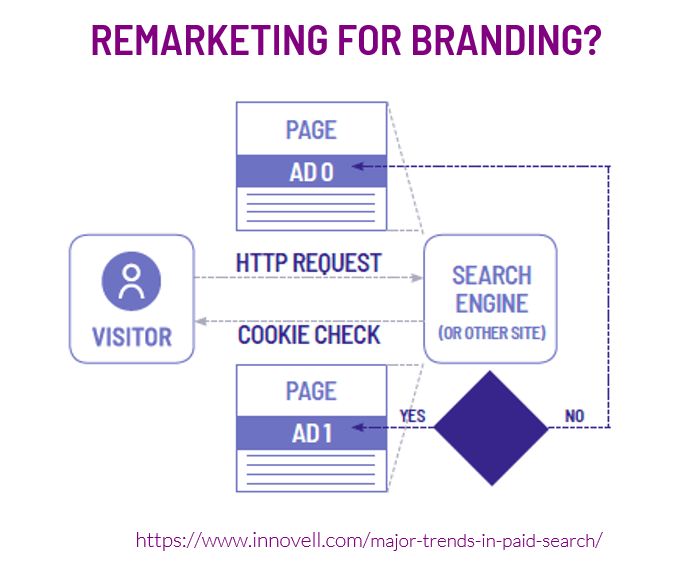 Remarketing had become very popular indeed. Why was that again? Well because it generated “proven” conversions. It generated performance. Certainly not because of its (non-existent) capability to build brand awareness. This was of course before remarketing became really unpopular with users who felt stalked by cookie-fuelled remarketing ads for things they didn’t want or already bought.
Remarketing had become very popular indeed. Why was that again? Well because it generated “proven” conversions. It generated performance. Certainly not because of its (non-existent) capability to build brand awareness. This was of course before remarketing became really unpopular with users who felt stalked by cookie-fuelled remarketing ads for things they didn’t want or already bought.
Today marketers build advertising campaigns with a nuanced understanding of their audiences. They assume that each individual member of an audience will go through various stages on his/her journey towards the product or service we advocate. They can do detailed analysis of the end users’ characteristics in the shape of Personas and then try to understand in which way they can be touched and influenced in each of the phases they are going through.
The original user-journey mapping concept, the purchase funnel, originates from E. St. Elmo Lewis, who in 1898 described his AIDA model, which has four stages: awareness, interest, desire and action. This model was later adopted in the fields of marketing, sales and, more recently, ecommerce. The logic of the funnel is that you qualify and thus reduce your marketing scope when you pass from one stage to the next. This fits well with the measure-everything philosophy of digital marketing, where goal, transformation and tracking points can be established for each passage.
We used a simplified version of this model in our research for the Search Trends Report and it was clear that the most advanced players in the space we looked at, had a very broad scope of analysis for this. They considered it essential to understand this user-journey and most of them mapped their campaigns to the user journey in one way or another.
For a deeper look into how the most advanced paid search marketers consider understanding the user journey essential and look well beyond their main marketing channel in order to target users during their journey, you should read this article: Where does paid search fit into the user journey? 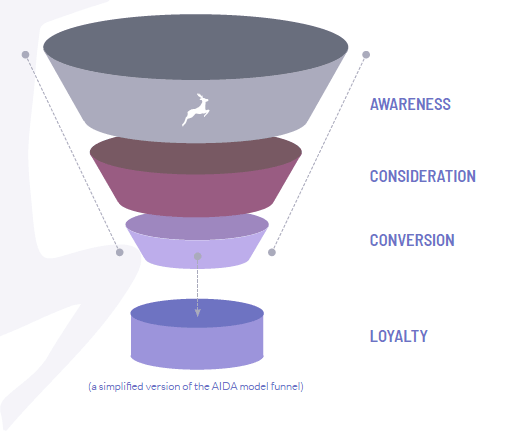
Early digital marketing was linear
When digital marketing first took off – as is the case for many marketing approaches – it was driven by strong converters. The most successful paid search campaigns 15 years ago were all trying to trigger an impulse buy and move along a straight line from which the user was not meant to deviate.
The set up would look like this:
- find a “money keyword” (a keyword which indicates that the user who made the search query has a strong intent – a buying intent)
- optimize a landing page with a view to immediate conversion
- overbid everybody on the money keyword so you would harvest a maximum amount of visitors
- split test the landing page to continuously improve its conversion rate
In the wild west of early paid search marketing, this approach made people rich. It also drove up competition and therefore auction prices and therefore made the search engines rich too. Those campaigns would be considered “performance” campaigns as everything was related to conversion: investment levels, remuneration of those involved.
And on the opposite side of the spectrum you would have the Brand campaigns. They would simply aim to position the brand in relation with the right queries or on the right websites. They would measure the number of impressions that were generated by their ads and would tie a lot more importance to being at the top of the page than to how many click-throughs that position generated, as there was no direct conversion on the destination site. A landing page could be a homepage.
Those two worlds – performance and brand – were very far from each other.
Digital marketing has come a long way since those early days. In performance campaigns, competition and cost increased, but so did targeting options and data availability, making the playing field more complex. Brand campaigns began to look at longer term value due to improvements in tracking and would start to synchronize with Performance-related activities.
State of the Art in 2019
When looking at hundreds of case studies we would have expected to see quite sophisticated set-ups for campaigns, but one of the things that struck us was that they rarely described more than 2 campaign phases. Two is of course a fundamental advancement compared to the former linear campaigns but with teams insisting on having in-depth understanding of the full user journey, it seemed simplistic still. The first phase would be essentially focused on Awareness (and/or Interest) and the second phase dedicated to Conversion. So where did that Consideration stage go?
In fact, it is hiding in there although it doesn’t have a dedicated campaign phase. All the communication that is being redirected at a Consideration-stage audience is usually tied together either with the preceding phase or the following phase. As an example, for Awareness campaigns, remarketing audiences will typically be addressed for consideration rather than directly for conversion. And in a conversion campaign, to broaden and qualify audiences, « inmarket » audiences will be used. These are covering our Consideration stage, so let’s have a look at a number of ways in which they appear in no particular order:
- Media partnerships
Many large advertisers establish medium/long-term media partnerships. This allows them to have a continuous visibility and sometimes interactivity with a part of their consideration stage audience. - Brand searches
It is well known that searches with brand terms are among the most likely to convert. Brand searches are on the brink of conversion – sometimes the user will be an existing client (what’s their address, how do I log-in), sometimes they will be conversion audiences (let me find the website so I can buy the product) and then sometimes they will be in the consideration stage (on my list of alternatives I visit every brand to help me choose). It is useful to segment brand searchers by the use of customer match and remarketing audiences to identify those who are really in a consideration stage. - Remarketing to derived audiences
From an awareness campaign, it is sometimes possible to create derived audiences of those who have seen a video ad or those who have otherwise engaged or simply been exposed. These will be consideration stage audiences not yet ready to convert and in need of positive reminders of a brands existence. - Inmarket audiences
Due to increasing amounts of data and machine-learning algorithms applied to user data, it has become possible to define audiences which have a higher probability of Intent. This is very close to the definition of the Consideration stage. These Intent audiences are often labelled “inmarket” referring to a user being “in the market for …”. They are of course sector- and sub-sector specific. - Prospect nurturing
B2B digital marketing had a slow start compared to B2C. One of the reasons was that it becomes proportionally more difficult to track efficiently, the longer your sales cycle is and the more stakeholders are involved. And in B2B sales cycles are long and there are typically multiple stakeholders. One of the successful approaches used by B2B marketers is what is referred to as Inbound Marketing. It is a content-driven approach which aims to establish a relationship on the basis of an initial positive interaction and typically register an email address which enables for a process called “nurturing”. This process is typically mapped to a typical sales cycle and addresses the needs of the persona. This entire concept is clearly the materialization of a well-defined consideration stage.
In our research, it is still rare to see campaigns entirely mapped to a user journey. We believe the best possible strategic planning takes the route of audience research, persona building and user journey mapping and that doing this will become increasingly important and also increasingly mainstream as the number of variables in the digital marketing equation continues to increase.
We have, however, come a very long way since the initial duality of Performance on one hand and Brand on the other. Most advertisers are trying to build their path down from Awareness or up from Conversion to try to guide the user at every stage towards their offering. And excellent marketers also think beyond conversion as new opportunities in loyalty and advocacy are arising.


